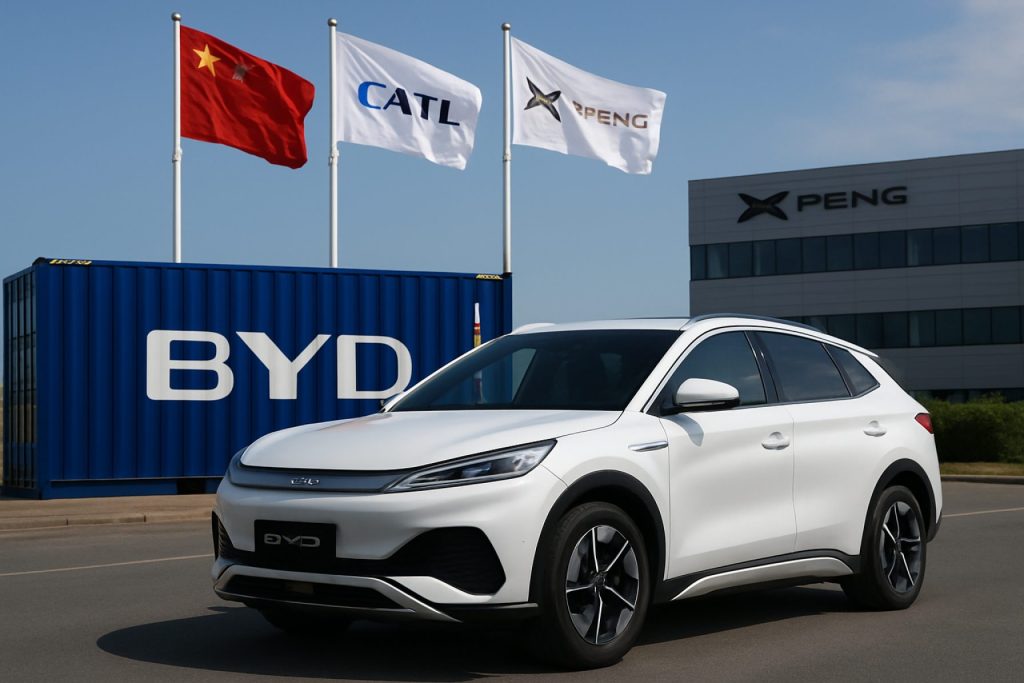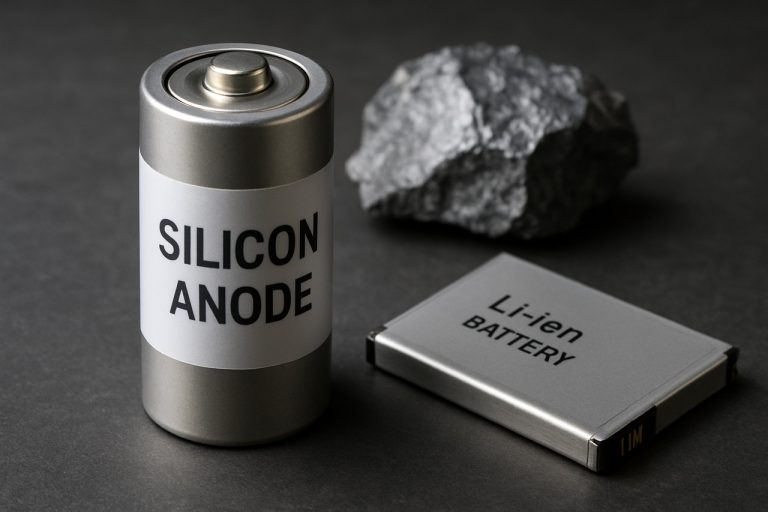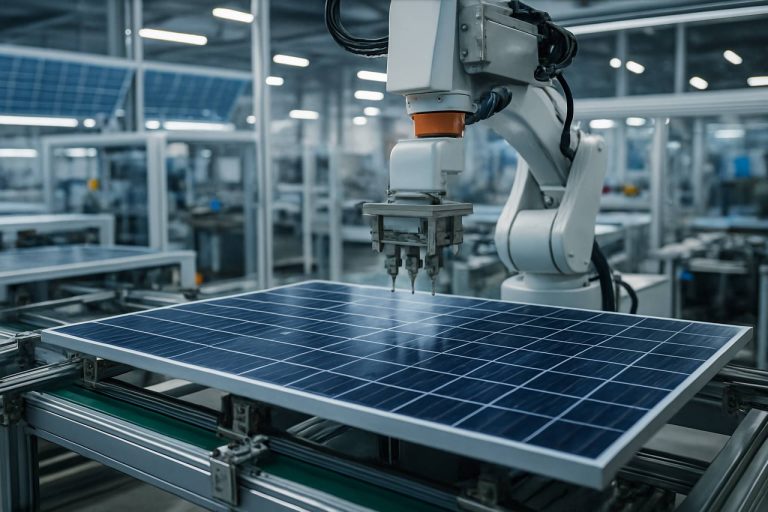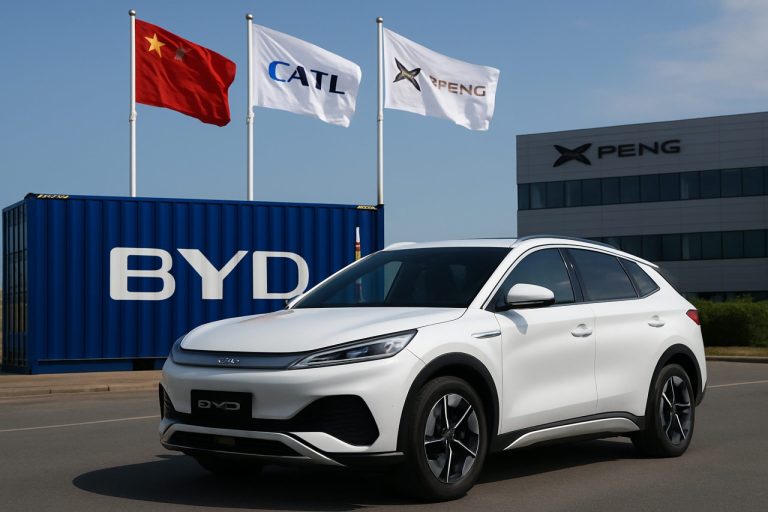
How BYD, CATL, and Xpeng Are Redefining Global EV Exports in 2025: Unpacking China’s Unstoppable Rise and What It Means for the Next Five Years
- Executive Summary: The New Era of Chinese EV Export Leadership
- 2025 Market Overview: BYD, CATL, and Xpeng’s Global Footprint
- Export Volume & Growth Projections (2025–2029): Market Share and CAGR Analysis
- Technology Innovations: Battery, Powertrain, and Platform Advances
- Supply Chain Mastery: Vertical Integration and Global Partnerships
- Regulatory Landscape: Compliance, Tariffs, and International Policy
- Competitive Positioning: Comparing Chinese Leaders to Global Rivals
- Key Export Destinations: Europe, Southeast Asia, and Emerging Markets
- Sustainability and ESG: Environmental Impact and Corporate Initiatives
- Future Outlook: Strategic Roadmaps and Disruptive Trends to 2030
- Sources & References
Executive Summary: The New Era of Chinese EV Export Leadership
The global electric vehicle (EV) landscape is undergoing a profound transformation, with Chinese manufacturers emerging as dominant exporters and technology leaders. As of 2025, companies such as BYD Company Limited, Contemporary Amperex Technology Co., Limited (CATL), and XPeng Inc. are at the forefront of this shift, leveraging advanced manufacturing, battery innovation, and aggressive international expansion strategies.
BYD, headquartered in Shenzhen, has rapidly ascended to become the world’s largest EV manufacturer by volume, surpassing traditional Western and Japanese automakers in several key markets. In 2024 and into 2025, BYD’s export volumes have surged, with the company shipping passenger vehicles and electric buses to over 70 countries. Its “Blade Battery” technology, known for safety and energy density, underpins its competitive edge. BYD’s European and Latin American market entries have been particularly notable, with localized assembly and partnerships accelerating adoption. The company’s vertically integrated model—spanning battery production, vehicle assembly, and even semiconductor manufacturing—enables cost control and rapid scaling (BYD Company Limited).
CATL is the world’s largest EV battery supplier, providing lithium-ion batteries not only to Chinese automakers but also to global brands. In 2025, CATL’s export leadership is evident in its supply agreements with major European and Asian automakers, as well as its investments in overseas battery plants. The company’s focus on next-generation chemistries, such as sodium-ion and solid-state batteries, positions it as a technology pacesetter. CATL’s global footprint is expanding, with new facilities in Germany and Hungary supporting the European EV boom. Its ability to deliver high-volume, high-quality battery packs at competitive prices is a cornerstone of China’s export momentum (Contemporary Amperex Technology Co., Limited).
XPeng, a leading smart EV manufacturer, exemplifies China’s push into premium and technologically advanced vehicles. XPeng’s exports to Europe and Southeast Asia have grown steadily, supported by its proprietary autonomous driving systems and over-the-air software updates. The company’s focus on innovation—ranging from high-efficiency powertrains to intelligent cockpit experiences—caters to tech-savvy global consumers. XPeng’s international strategy includes direct sales, local partnerships, and the establishment of service networks to ensure customer support abroad (XPeng Inc.).
Looking ahead, the next few years are expected to see continued growth in Chinese EV exports, driven by cost advantages, rapid innovation cycles, and supportive government policies. As trade dynamics evolve and global demand for affordable, high-quality EVs accelerates, Chinese firms are poised to solidify their leadership in the international market, reshaping the competitive landscape for years to come.
2025 Market Overview: BYD, CATL, and Xpeng’s Global Footprint
In 2025, Chinese electric vehicle (EV) manufacturers and suppliers are consolidating their leadership in global EV exports, with BYD Company Limited, Contemporary Amperex Technology Co., Limited (CATL), and Xpeng Inc. at the forefront. These companies are not only expanding their international market presence but also shaping the competitive landscape through innovation, scale, and strategic partnerships.
BYD has emerged as the world’s largest EV manufacturer by volume, surpassing traditional automakers in both domestic and international sales. In 2024 and into 2025, BYD’s aggressive export strategy has seen its passenger vehicles enter over 70 countries, with a particular focus on Europe, Southeast Asia, and Latin America. The company’s “Ocean” and “Dynasty” series models, such as the Atto 3 and Seal, have gained traction in markets with stringent emissions standards. BYD’s vertically integrated supply chain, encompassing battery production, semiconductor manufacturing, and vehicle assembly, enables cost advantages and rapid adaptation to local regulations. The company’s overseas manufacturing investments, including new plants in Thailand and Brazil, are expected to further boost its export capacity and reduce logistical barriers (BYD Company Limited).
CATL, the world’s largest EV battery supplier, underpins much of China’s export momentum. In 2025, CATL’s lithium-ion battery technologies power not only Chinese brands but also global automakers, including partnerships with European and American OEMs. CATL’s expansion of overseas production—such as its battery plants in Germany and Hungary—supports the localization of supply chains for exported Chinese EVs and strengthens its position as a critical enabler of global electrification. The company’s advancements in battery chemistry, including sodium-ion and long-range lithium iron phosphate (LFP) cells, are expected to further enhance the competitiveness of Chinese EV exports by offering improved performance and cost efficiency (Contemporary Amperex Technology Co., Limited).
Xpeng, while smaller in scale than BYD, is rapidly expanding its global footprint. In 2025, Xpeng’s smart EVs—renowned for their advanced driver-assistance systems and connectivity features—are being introduced to European markets, with pilot sales and service networks established in countries such as Norway, the Netherlands, and Germany. Xpeng’s focus on software innovation and autonomous driving technology positions it as a premium contender among Chinese exporters, appealing to tech-savvy consumers and differentiating its offerings from both domestic and international rivals (Xpeng Inc.).
Looking ahead, the combined export leadership of BYD, CATL, and Xpeng is expected to intensify competition in the global EV market. Their continued investments in overseas manufacturing, technology, and localized services are likely to accelerate the adoption of Chinese EVs worldwide, with significant implications for market share, supply chain dynamics, and the pace of automotive electrification through 2025 and beyond.
Export Volume & Growth Projections (2025–2029): Market Share and CAGR Analysis
China’s electric vehicle (EV) industry has rapidly ascended to global prominence, with leading manufacturers such as BYD Company Limited, Contemporary Amperex Technology Co., Limited (CATL), and XPeng Inc. spearheading export growth. As of 2025, these companies collectively account for a significant share of the world’s EV exports, with projections indicating continued expansion through 2029.
In 2024, China surpassed all other nations in EV exports, shipping over 1.2 million electric vehicles globally, a figure expected to rise to approximately 1.5 million units in 2025. BYD, the world’s largest EV manufacturer by sales volume, is at the forefront, with its export volume projected to exceed 400,000 units in 2025. The company’s aggressive overseas expansion—particularly in Europe, Southeast Asia, and Latin America—has been underpinned by a diverse product lineup and competitive pricing. BYD is also investing in overseas manufacturing facilities, further supporting its export ambitions.
CATL, the world’s leading EV battery supplier, plays a pivotal role in enabling Chinese EV export growth. While not a vehicle manufacturer, CATL supplies batteries to both domestic and international automakers, including BYD and XPeng. Its global battery shipments are projected to grow at a compound annual growth rate (CAGR) of over 20% from 2025 to 2029, supporting the expansion of Chinese EV exports and the electrification of fleets worldwide.
XPeng, a leading smart EV manufacturer, is also ramping up its export activities. The company’s focus on intelligent driving technology and premium features has positioned it well in European and Middle Eastern markets. XPeng aims to double its export volume by 2026, with a CAGR in export shipments estimated at 25% through 2029.
Collectively, Chinese EV manufacturers are projected to maintain a global export market share exceeding 35% by 2029, up from approximately 30% in 2025. The overall CAGR for Chinese EV exports is forecasted at 12–15% over the 2025–2029 period, outpacing the global average. This growth is driven by continued investment in overseas production, battery technology leadership from CATL, and the ability of companies like BYD and XPeng to adapt products for diverse international markets.
Technology Innovations: Battery, Powertrain, and Platform Advances
China’s electric vehicle (EV) sector has rapidly ascended to global prominence, with companies such as BYD Company Limited, Contemporary Amperex Technology Co., Limited (CATL), and Xpeng Inc. at the forefront of export leadership. In 2025, these firms are not only dominating domestic sales but are also aggressively expanding their international footprint, leveraging advanced technology innovations in batteries, powertrains, and vehicle platforms.
BYD, now the world’s largest EV manufacturer by volume, has made significant strides in battery and platform technology. Its proprietary Blade Battery, a lithium iron phosphate (LFP) design, offers enhanced safety, longevity, and cost efficiency, making it a preferred choice for both domestic and export models. The company’s e-Platform 3.0, introduced in recent years, integrates powertrain, battery, and vehicle control systems for improved efficiency and modularity, enabling rapid adaptation to diverse global markets. In 2025, BYD’s export strategy includes localized production in key regions such as Europe and Southeast Asia, with new plants and joint ventures accelerating its overseas deliveries and compliance with local regulations (BYD Company Limited).
CATL, the world’s leading EV battery supplier, underpins much of China’s export momentum through its technological leadership in battery chemistry and manufacturing scale. In 2025, CATL continues to supply advanced lithium-ion and LFP batteries to a broad spectrum of automakers, including international brands and emerging Chinese exporters. The company’s latest innovations, such as condensed matter batteries and rapid-charging cell designs, are being integrated into export-oriented vehicles, offering higher energy density and faster charging—key differentiators in competitive overseas markets. CATL’s global expansion includes new gigafactories in Europe and partnerships with automakers to ensure secure, localized battery supply chains (Contemporary Amperex Technology Co., Limited).
Xpeng, a leader in smart EVs, is leveraging its proprietary X-EEA 3.0 electronic architecture and advanced driver-assistance systems (ADAS) to appeal to tech-savvy international consumers. In 2025, Xpeng’s export models feature high-voltage SiC (silicon carbide) powertrains for improved efficiency and range, as well as over-the-air (OTA) software updates and intelligent cockpit systems. The company’s focus on autonomous driving and digital user experience positions it as a strong contender in Europe and the Middle East, where regulatory acceptance of advanced driver-assistance features is growing (Xpeng Inc.).
Looking ahead, the combined technological advances and aggressive export strategies of BYD, CATL, and Xpeng are expected to further solidify China’s leadership in the global EV market through 2025 and beyond. Their ability to innovate in battery chemistry, powertrain efficiency, and intelligent vehicle platforms will be critical as they navigate evolving international standards and consumer preferences.
Supply Chain Mastery: Vertical Integration and Global Partnerships
Chinese electric vehicle (EV) manufacturers have rapidly ascended to global leadership in exports, underpinned by sophisticated supply chain mastery, vertical integration, and a web of international partnerships. As of 2025, companies such as BYD Company Limited, Contemporary Amperex Technology Co., Limited (CATL), and Xpeng Inc. are at the forefront of this transformation, leveraging their control over key components and strategic alliances to expand their global footprint.
BYD exemplifies vertical integration, manufacturing not only vehicles but also batteries, semiconductors, and electric drivetrains in-house. This approach has enabled BYD to maintain cost competitiveness and supply chain resilience amid global disruptions. In 2024 and 2025, BYD’s export volumes have surged, with the company shipping EVs to over 70 countries, including major markets in Europe, Southeast Asia, and Latin America. BYD’s global partnerships, such as joint ventures for localized assembly and battery production, further cement its export leadership. The company’s ability to rapidly scale production and adapt to local regulatory requirements has made it a preferred partner for international distributors and fleet operators (BYD Company Limited).
CATL, the world’s largest EV battery manufacturer, plays a pivotal role in the supply chain strategies of both Chinese and international automakers. CATL’s vertical integration extends from raw material sourcing to battery recycling, ensuring security of supply and cost control. In 2025, CATL continues to expand its overseas manufacturing footprint, with operational or planned battery plants in Europe and Southeast Asia. Strategic partnerships with global OEMs, including supply agreements and joint R&D initiatives, have positioned CATL as a linchpin in the global EV ecosystem. Its ability to deliver advanced battery chemistries at scale supports the export ambitions of Chinese EV brands and their international partners (Contemporary Amperex Technology Co., Limited).
Xpeng has adopted a hybrid approach, combining in-house development of core technologies—such as autonomous driving systems and vehicle software—with strategic supplier relationships. In 2025, Xpeng’s export strategy focuses on Europe and the Middle East, leveraging partnerships for local distribution, after-sales service, and compliance with regional standards. Xpeng’s investment in proprietary manufacturing and R&D facilities ensures quality control and rapid innovation cycles, while collaborations with battery and component suppliers optimize cost and supply chain flexibility (Xpeng Inc.).
Looking ahead, the continued expansion of Chinese EV exports is expected to be driven by further vertical integration, deeper global partnerships, and ongoing investment in supply chain resilience. These strategies will likely reinforce the leadership of BYD, CATL, and Xpeng in the international EV market through 2025 and beyond.
Regulatory Landscape: Compliance, Tariffs, and International Policy
The regulatory landscape for Chinese electric vehicle (EV) exports in 2025 is defined by a complex interplay of compliance requirements, evolving tariffs, and shifting international policy. As China’s leading EV manufacturers—BYD Company Limited, Contemporary Amperex Technology Co., Limited (CATL), and Xpeng Inc.—expand their global reach, they face both opportunities and challenges shaped by regulatory frameworks in key export markets.
In 2025, BYD continues to lead Chinese EV exports, leveraging its vertically integrated supply chain and growing overseas manufacturing footprint. The company has established assembly plants and partnerships in regions such as Southeast Asia, South America, and Europe, aiming to mitigate the impact of tariffs and local content requirements. CATL, the world’s largest EV battery producer, is similarly expanding its global presence, supplying batteries to both Chinese and international automakers, and investing in overseas battery plants to comply with local sourcing rules. Xpeng, while smaller in scale, is actively pursuing European market entry, adapting its vehicles to meet stringent EU safety and emissions standards.
Tariffs remain a central issue. In 2024 and 2025, the European Union has intensified scrutiny of Chinese EV imports, citing concerns over state subsidies and market distortion. Provisional tariffs on Chinese EVs, ranging from 17% to over 30%, have been implemented or proposed, directly impacting the competitiveness of Chinese brands in Europe. The United States maintains even higher tariffs on Chinese EVs and batteries, effectively limiting direct exports and prompting Chinese firms to explore alternative markets or localize production outside China.
Compliance with international standards is another critical factor. Chinese EV makers must navigate a patchwork of homologation, safety, and environmental regulations. For example, the European Union’s Whole Vehicle Type Approval (WVTA) system requires rigorous testing and certification, while battery suppliers like CATL must meet evolving requirements for battery traceability, recycling, and carbon footprint disclosure. These compliance demands are driving increased investment in R&D and local partnerships.
Looking ahead, the regulatory environment is expected to remain dynamic. Chinese EV leaders are responding by accelerating overseas investment, forming joint ventures, and adapting product portfolios to local preferences and rules. The outcome will depend on ongoing trade negotiations, the evolution of local content rules, and the ability of Chinese firms to demonstrate compliance and sustainability leadership in global markets.
Competitive Positioning: Comparing Chinese Leaders to Global Rivals
In 2025, Chinese electric vehicle (EV) manufacturers have solidified their position as global export leaders, with companies such as BYD Company Limited, Contemporary Amperex Technology Co. Limited (CATL), and Xpeng Inc. at the forefront. These firms have leveraged scale, technological innovation, and aggressive international strategies to outpace many established global rivals in both vehicle and battery exports.
BYD has emerged as the world’s largest EV manufacturer by volume, surpassing traditional Western and Japanese automakers in several key export markets. In 2024 and into 2025, BYD’s export volumes have continued to climb, with the company shipping passenger vehicles to over 70 countries and regions. Its competitive edge lies in vertical integration—BYD produces its own batteries, powertrains, and semiconductors, enabling cost control and rapid innovation. The company’s “Blade Battery” technology, known for safety and energy density, has become a selling point in Europe, Southeast Asia, and Latin America. BYD’s overseas manufacturing plants, such as those in Thailand and Brazil, further support its global ambitions and reduce exposure to trade barriers.
CATL, the world’s largest EV battery supplier, plays a pivotal role in the global EV supply chain. In 2025, CATL’s batteries power not only Chinese brands but also vehicles from leading international automakers. The company’s export leadership is underpinned by its advanced lithium iron phosphate (LFP) and nickel manganese cobalt (NMC) battery technologies, which offer a balance of cost, safety, and performance. CATL’s global footprint includes manufacturing facilities and partnerships in Europe and Southeast Asia, ensuring proximity to major automotive hubs and compliance with local content requirements. Its ability to supply high-volume, high-quality batteries at competitive prices has made it a preferred partner for both Chinese and foreign OEMs.
Xpeng has distinguished itself through a focus on smart, connected vehicles and autonomous driving features. In 2025, Xpeng’s export strategy targets tech-savvy consumers in Europe and the Middle East, with models such as the G9 SUV and P7 sedan. The company’s in-house software development and over-the-air update capabilities provide a competitive edge in markets where digital experience is a key differentiator. Xpeng’s partnerships for charging infrastructure and after-sales support in overseas markets further enhance its export competitiveness.
Looking ahead, the export leadership of BYD, CATL, and Xpeng is expected to intensify as they invest in local production, R&D centers, and strategic alliances abroad. Their ability to combine cost efficiency, technological innovation, and rapid market adaptation positions them strongly against global rivals, particularly as demand for affordable, high-quality EVs accelerates worldwide.
Key Export Destinations: Europe, Southeast Asia, and Emerging Markets
Chinese electric vehicle (EV) manufacturers have rapidly established themselves as global leaders in EV exports, with BYD Company Limited, Contemporary Amperex Technology Co., Limited (CATL), and XPeng Inc. at the forefront. As of 2025, these companies are leveraging their technological advancements, cost efficiencies, and robust supply chains to expand aggressively into key international markets, particularly Europe, Southeast Asia, and a range of emerging economies.
Europe remains a primary destination for Chinese EV exports. BYD, the world’s largest EV manufacturer by sales volume, has made significant inroads by launching multiple models tailored for European consumers and establishing local partnerships and assembly facilities. In 2024 and early 2025, BYD expanded its presence in countries such as Germany, the United Kingdom, and Norway, with plans to further localize production to circumvent potential trade barriers and tariffs. XPeng, known for its smart, connected vehicles, has also increased its shipments to Europe, focusing on markets receptive to advanced driver-assistance systems and digital features. Both companies are capitalizing on the European Union’s push for electrification and stricter emissions regulations, which have accelerated demand for affordable, high-quality EVs.
In Southeast Asia, Chinese EV makers are capitalizing on the region’s growing appetite for electrification and the relative lack of entrenched local competitors. BYD has established assembly plants and distribution networks in countries such as Thailand and Indonesia, positioning itself as a first mover in these rapidly developing markets. XPeng is following suit, targeting urban centers with rising middle classes and government incentives for EV adoption. CATL, the world’s largest battery manufacturer, underpins much of this expansion by supplying advanced lithium-ion battery technology not only to Chinese automakers but also to local and international OEMs, ensuring a reliable supply chain for the region’s burgeoning EV sector.
Emerging markets in Latin America, the Middle East, and Africa are also on the radar for Chinese EV exporters. BYD, in particular, has secured contracts for electric buses and passenger vehicles in countries such as Brazil, Chile, and Egypt, often working closely with local governments to support public transportation electrification. CATL’s global battery supply agreements further facilitate the entry of Chinese EVs into these markets, providing a competitive edge in terms of cost and technology.
Looking ahead to the remainder of 2025 and beyond, the outlook for Chinese EV export leadership remains robust. BYD, CATL, and XPeng are expected to deepen their market penetration through continued investment in overseas manufacturing, localized product development, and strategic alliances. Their ability to adapt to regulatory changes and consumer preferences in diverse regions will be critical to sustaining their export momentum and shaping the global EV landscape.
Sustainability and ESG: Environmental Impact and Corporate Initiatives
China’s electric vehicle (EV) sector has rapidly ascended to global prominence, with companies such as BYD Company Limited, Contemporary Amperex Technology Co., Limited (CATL), and Xpeng Inc. at the forefront of both export volume and sustainability initiatives. As of 2025, these firms are not only leading in international market penetration but are also intensifying their focus on environmental, social, and governance (ESG) performance to align with global standards and customer expectations.
BYD, the world’s largest EV manufacturer by sales, has made sustainability a core pillar of its export strategy. The company’s “Cool the Earth by 1°C” initiative underscores its commitment to reducing global carbon emissions through the proliferation of zero-emission vehicles and green manufacturing. BYD’s overseas expansion—particularly in Europe and Latin America—has been accompanied by the deployment of battery recycling programs and the establishment of solar-powered production facilities, aiming to minimize lifecycle emissions. The company’s 2024 ESG report highlights a 15% year-on-year reduction in energy consumption per vehicle produced and a significant increase in the use of renewable energy across its global operations (BYD Company Limited).
CATL, the world’s leading EV battery supplier, is pivotal in shaping the sustainability profile of Chinese EV exports. CATL’s “Green Factory” initiative, launched in 2023 and expanded through 2025, focuses on closed-loop battery manufacturing, water conservation, and the use of renewable energy in its gigafactories. The company has also established partnerships with global automakers to develop battery recycling and second-life applications, reducing the environmental impact of battery production and disposal. CATL’s 2025 sustainability targets include achieving carbon neutrality in its core operations and increasing the recycled content in its battery products to over 20% (Contemporary Amperex Technology Co., Limited).
Xpeng, a leading smart EV innovator, integrates ESG into its export and product development strategies. The company’s 2025 roadmap emphasizes the use of sustainable materials, energy-efficient manufacturing, and transparent supply chain management. Xpeng’s “Green Mobility” program, launched in 2024, aims to reduce the carbon footprint of its vehicles throughout their lifecycle, including overseas markets. The company is also investing in digital platforms to track and report ESG metrics, supporting compliance with evolving international regulations (Xpeng Inc.).
Looking ahead, the sustainability and ESG leadership of these Chinese EV exporters is expected to intensify, driven by stricter international standards and growing consumer demand for green mobility. Their ongoing investments in clean energy, circular economy practices, and transparent reporting position them to shape the global EV industry’s environmental agenda through 2025 and beyond.
Future Outlook: Strategic Roadmaps and Disruptive Trends to 2030
By 2025, Chinese electric vehicle (EV) manufacturers have firmly established themselves as global export leaders, with BYD Company Limited, Contemporary Amperex Technology Co., Limited (CATL), and Xpeng Inc. at the forefront. These companies have leveraged scale, technological innovation, and aggressive international expansion to reshape the global EV landscape.
BYD has become the world’s largest EV manufacturer by volume, surpassing traditional automakers in both battery electric and plug-in hybrid segments. In 2025, BYD’s export strategy is characterized by direct sales, local assembly partnerships, and the launch of region-specific models in Europe, Southeast Asia, and Latin America. The company’s “Ocean” and “Dynasty” series have been tailored for international markets, with production facilities in Thailand and Brazil coming online to circumvent tariffs and meet local demand. BYD’s vertical integration—spanning batteries, semiconductors, and complete vehicles—continues to provide cost and supply chain advantages (BYD Company Limited).
CATL, the world’s largest EV battery supplier, underpins much of China’s export momentum. In 2025, CATL’s global footprint includes gigafactories in Germany and Hungary, supporting both Chinese and European automakers. The company’s advancements in lithium iron phosphate (LFP) and sodium-ion battery technologies have enabled longer range and lower costs, making Chinese EVs more competitive abroad. CATL’s strategic partnerships with global OEMs and its “battery-as-a-service” model are expected to further accelerate adoption and exports through 2030 (Contemporary Amperex Technology Co., Limited).
Xpeng has positioned itself as a technology-driven challenger, focusing on smart EVs with advanced driver-assistance systems and over-the-air software updates. In 2025, Xpeng’s export roadmap targets Europe and the Middle East, with the G9 and P7 models gaining traction among tech-savvy consumers. The company’s investment in autonomous driving and AI-powered cockpit experiences is expected to differentiate its offerings as regulatory environments in export markets evolve (Xpeng Inc.).
Looking ahead to 2030, Chinese EV export leadership is likely to intensify. BYD, CATL, and Xpeng are expected to deepen localization in key markets, invest in next-generation battery chemistries, and expand their global R&D networks. However, they will also face challenges from evolving trade policies, local content requirements, and intensifying competition from established and emerging players. The strategic roadmaps of these companies suggest a continued focus on innovation, cost leadership, and ecosystem integration as the primary levers for sustaining export dominance.



